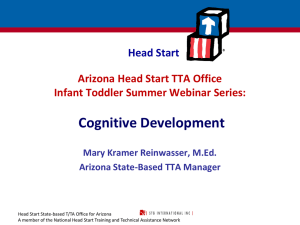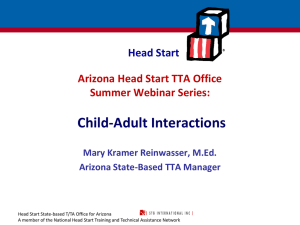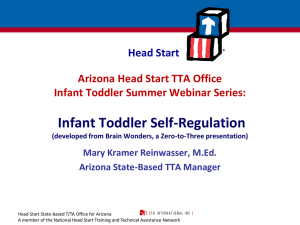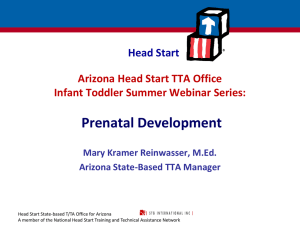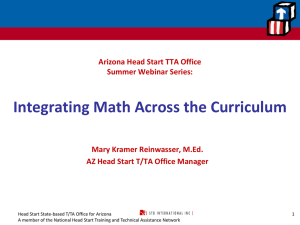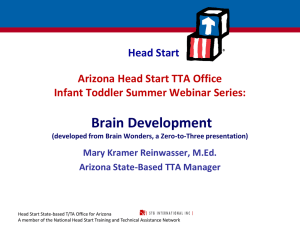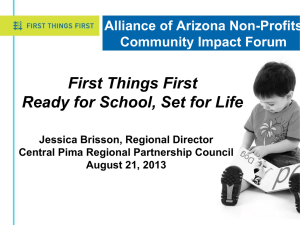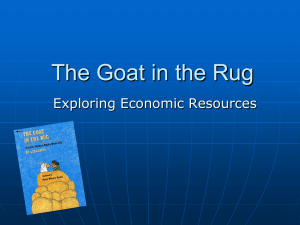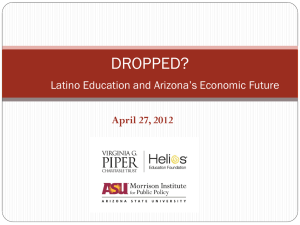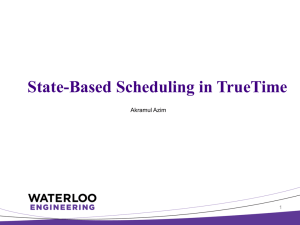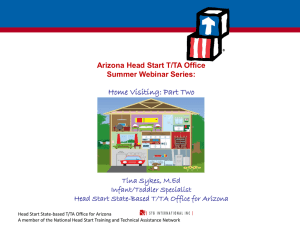Language Development - Arizona Head Start Association
advertisement
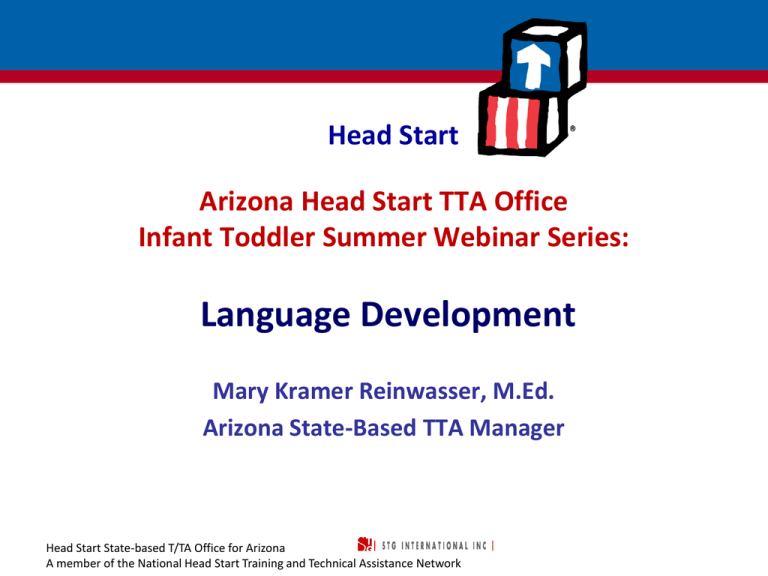
Head Start Arizona Head Start TTA Office Infant Toddler Summer Webinar Series: Language Development Mary Kramer Reinwasser, M.Ed. Arizona State-Based TTA Manager Head Start State-based T/TA Office for Arizona A member of the National Head Start Training and Technical Assistance Network Agenda • Define common terminology • Discuss theoretical viewpoints of language development • Identify stages of language development including milestones • Review characteristics that influence language development • Identify strategies to support language development Head Start State-based T/TA Office for Arizona A member of the National Head Start Training and Technical Assistance Network 2 Learning Outcomes • Participants will be able to define commonly used language terminology • Participants will be able to name language milestones in chronological order • Participants will be able to describe stages of language development • Participants will be able to identify strategies that support language development Head Start State-based T/TA Office for Arizona A member of the National Head Start Training and Technical Assistance Network 3 Using Common Terminology Dimensions: • Content (meaning) • Use (purpose) • Form (structure) Definitions • • • • • • • speech language communication morphology syntax semantics pragmatics Head Start State-based T/TA Office for Arizona A member of the National Head Start Training and Technical Assistance Network Theories of Language Development Behaviorist • • • • Imitation Conditioning Motivated by reinforcement B.F. Skinner Interactionist • • • • Biological Social Motivated by others Vygotsky Head Start State-based T/TA Office for Arizona A member of the National Head Start Training and Technical Assistance Network Stages of Language Development Prelinguistic: – Early sensitivity to language at birth – First Vocalizations Single Word Stage -- Holophrastic Period: – – – – Declarative: “Doggy big” Interrogative: “Where ball?” Negative: “Not egg” Imperative: “More cookie” Multiple Word Combinations: • • • • Declarative: “Doggy is big” Interrogative: “Where is ball?” Negative: “That is not an egg ” Imperative: “I want more cookie” Head Start State-based T/TA Office for Arizona A member of the National Head Start Training and Technical Assistance Network Language Milestones 12 weeks cooing, smiles when talked to 16 weeks turns head in response to human voice 20 weeks makes vowels and consonant sounds 6 months babbling (all sounds) 8 months repeat certain syllables (ma-ma) 12 months understands and says some words 18 months can produce up to 50 words 24 months more than 50 words, two-word phrases 30 months about 100 words, phrases of 3-5 words 36 months vocabulary of about 1,000 words 48 months most basic aspects of language are well established Head Start State-based T/TA Office for Arizona A member of the National Head Start Training and Technical Assistance Network 7 Necessary Conditions for Development of Communication Skills • • • • • • Sensory system Central Nervous System Motor system Cognitive abilities Social and Affective growth Responsive environment Head Start State-based T/TA Office for Arizona A member of the National Head Start Training and Technical Assistance Network Characteristics that Interfere with Communication and Speech Development • Hearing loss • Specific Language Impairment • Visual Disability • Cognitive Disability • Emotional Problems • Autism • Lack of Interaction • • • • Structural abnormality Motor problems Voice disorders Disfluency disorders Head Start State-based T/TA Office for Arizona A member of the National Head Start Training and Technical Assistance Network Early Relationships: The Context for Learning • Interactions are opportunities for communication and language development. – Infant/toddler learns to relate/communicate. • Responsive consistent care-giving nurtures reciprocal interactions – Caregivers provide auditory/visual input, pause and wait for a response from baby. • Reciprocal interactions are the context for learning – Early literacy development unfolds. Head Start State-based T/TA Office for Arizona A member of the National Head Start Training and Technical Assistance Network 10 Strategies for Everyone • Follow the lead of the infant – respond to and extend engagement in interesting toys/objects • Speak in parentese – draw the infant’s attention to the rhyme and rhythm of language • Pause within interactions – allow time for the infant to process information and respond • Use brief sentences – reference or point to objects in the child’s visual field Head Start State-based T/TA Office for Arizona A member of the National Head Start Training and Technical Assistance Network ©CENTe-R 2005 More Strategies • Use a variety of language features. – Intonation – Pitch – Rhythm – Volume – Pausing • Allow wait time for child to listen/watch, process, and respond. Head Start State-based T/TA Office for Arizona A member of the National Head Start Training and Technical Assistance Network ©CENTe-R 2005 Repeating & Repeating Plus • Repeating what the child says – Child says: “Juice all gone.” – Adult says: “Juice all gone.” • Repeating and Adding to what the child has said – Child says: “Hot out there.” – Adult says: “ It’s hot in here too.” Head Start State-based T/TA Office for Arizona A member of the National Head Start Training and Technical Assistance Network ©CENTe-R 2005 Expanding and Describing • Adding to what the child has said – Child says: “Raining outside.” – Adult says: “Yes, it’s raining all over.” • Describing what you are seeing, hearing, doing as you do it - Self Talk – While washing dishes, adult says: “Wash the dish and now we rinse the dish.” Head Start State-based T/TA Office for Arizona A member of the National Head Start Training and Technical Assistance Network ©CENTe-R 2005 Parallel Communicating • Parallel talk: Talking about what the child is doing, thinking or feeling – Child is bouncing a ball; – Adult says: “You’re bouncing the ball.” or “Jose is bouncing the ball. The ball is bouncing up and down.” – Use “you” or say the child’s name. Head Start State-based T/TA Office for Arizona A member of the National Head Start Training and Technical Assistance Network ©CENTe-R 2005 Labeling & Answering • Labeling - Use labeling or explaining phrases or statements – Adult says: “That’s a big blue beach ball.” or “That dog is a poodle.” • Answering the child’s question – Child says: “Gampa’s?” – Adult says: “Yes, we are going to Gampa’s now.” Head Start State-based T/TA Office for Arizona A member of the National Head Start Training and Technical Assistance Network ©CENTe-R 2005 Expansions & Extensions • Expansion - Repeating child’s utterance the way an adult would have said it – Child says: “Doggy run” – Adult says: “Yes, the doggy is running.” • Extension - Expanding the child’s response to an adult sentence, then adding an additional related comment. – Child says: “Car go” – Adult says: “The car is going. It’s a red car.” Head Start State-based T/TA Office for Arizona A member of the National Head Start Training and Technical Assistance Network ©CENTe-R 2005 Encouraging Infant Communication • Create a language rich environment that includes novel materials and varied toys for interaction – narrate the infant’s world with expression • Initiate frequent engaging interaction with infants – look for meaningful opportunities to initiate or respond to baby’s interest • Attract baby’s attention – tap on the toy/object that is the focus of communication prior to initiation of interaction • Make eye contact – position oneself and toys/objects in the infant’s visual field when interacting Head Start State-based T/TA Office for Arizona A member of the National Head Start Training and Technical Assistance Network 18 Opportunities for Communication • Listen for the infant’s/toddler’s communicative responses/behaviors – What is the baby trying to communicate? • Use observation to identify infant/toddler vocalizations, cues and signs – Does the baby need food, diaper change, or just want to play? – How can I extend the interaction? Head Start State-based T/TA Office for Arizona A member of the National Head Start Training and Technical Assistance Network 19 Bathe child in language Be responsive when children initiate communication Engage in nonverbal communication Use child-directed language Use self talk and parallel talk Help children expand language • Support bilingual development • Attend to individual development and needs • Engage infants with books and stories • Be playful with language • Create a communication friendly environment • Name children’s interests Head Start State-based T/TA Office for Arizona A member of the National Head Start Training and Technical Assistance Network 20 Summary • Acquiring language is complex. Young children play an active role in learning language. • Under typical circumstances, young children learn language. Experience with communication and language is key. • Language development varies from individual to individual and from social-cultural context to social-cultural context. • Young children learn language in the context of human relationships. Experience with language typically occurs during everyday routines/activities. Head Start State-based T/TA Office for Arizona A member of the National Head Start Training and Technical Assistance Network 21 The Arizona Head Start Training and Technical Assistance Office and STG International thank you for joining our webinar today! Please continue to join the 2010 Summer Webinar Series occurring every Tuesday and Thursday during the months of June and July at 3:00 Pacific Daylight Time. Please contact Mary Kramer Reinwasser at mary.reinwasser@stginternational.com for more information. Head Start State-based T/TA Office for Arizona A member of the National Head Start Training and Technical Assistance Network 22

